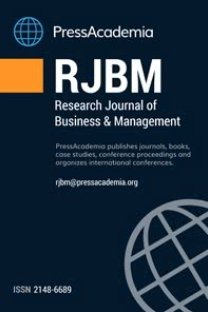THE EFFECTS OF ORGANIZATIONAL JUSTICE PERCEPTIONS ON CYBER-LOAFING BEHAVİORS: A RESEARCH ON HEALTH WORKERS
Operational justice interactionel justice organizational justice, cyber-loafing, health workers,
___
- Ahmadi, H., Bagheri, F., Ebrahimi, SA., Rokni, MAN., Kahreh, MS. 2011, “Deviant Work Behavior: Explaining Relationship between Organizational Justice and Cyber-Loafing as a Deviant Work Behavior”, American Journal of Scientific Research, 24,pp.103-116.
- Blanchard, A. L. & Henle, CA. 2008, “Correlates of Different Forms of Cyberloafing: The Role of Norms and External Locus of Control”, Computers in Human Behavior, vol.24, no.3, pp. 1067-1084.
- Bies, R.J., Moag, J.S. 1986, “Interactional justice: Commu-nication criteria of fairness”. In R. J. Lewicki, B H. Sheppard, & M. H. Bazerman (Eds.), Research on negotiation in organizations,, pp. 43-55.
- Colquitt, J. A., & Chertkoff, J. M. 2002, “Explaining injustice: The Interactive Effect of Explanation and Outcome on Fairness Perceptions and Task Motivation”, Journal of Management, vol.28, no. 5, pp. 591-610.
- Cropanzano R. and Greenberg J. 1997, Chapter to appear in C. L. Cooper & I. T. Robertson (Eds.). Iptematjonal Review of Industrial and Orpnizational Psychology. New York: John Wiley & Sons.
- Eivazi, K. 2011, “Computer Use Monitoring and Privacy at Work”, Computer Law & Security Review, vol.27, no.5, pp. 516-523.
- Forret, M. & Love, M. S. 2008, “Employee Justice Perception and Coworker Relationship”. Leaderships & Organization Development, vol.29, no. 3, pp.248-260.
- Greenberg, J. 1990, “Organizational justice: Yesterday, today, and tomorrow”, Journal of management, vol.16, no. 2, pp.399-432.
- İnce, M. & Gül, H. 2011, “The Relation of Cyber Slacking Behaviors with Various Organizational Outputs: Example of Karamanoğlu Mehmetbey University”, European Journal of Scientific Research, vol. 52, , no. 4, pp.507-527.
- İşcan, Ö. F. & Sayın, U. 2010, “Örgütsel Adalet, İş Tatmini ve Örgütsel Güven Arasındaki İlişki”, Atatürk Üniversitesi İktisadi ve İdari Bilimler Dergisi, vol.24, , no. 4, pp. 195‐216.
- Kaplan M. & Çetinkaya A.Ş 2014, “Sanal Kaytarma ve Demografik Özellikler Açısından Farklılıklar: Otel İşletmelerinde Bir Araştırma”, Anatolia: Turizm Araştırmaları Dergisi, vol.25, no. 1, pp.26 – 34.
- Kaplan, M. & Öğüt, A. 2012, “Algılanan Örgütsel Adalet İle Sanal Kaytarma Arasındaki İlişkinin Analizi: Hastane Çalışanları Örneği”, İşletme Fakültesi Dergisi, vol.13, no. 1, pp. 1-13.
- Keklik, B., Kılıç, R., Yıldız, H., & Yıldız, B. 2015, “Sanal Kaytarma Davranışlarının Örgütsel Öğrenme Kapasitesi Üzerindeki Etkisinin İncelenmesi/An Investigation of the Effect of Cyberloafing Behaviors on Organizational Learning Capacity”, Business and Economics Research Journal, vol.6, no. 3, pp. 129-144.
- Kim, S. J. & Byrne, S. 2011, “Conceptualizing Personal Web Usage in Work Contexts: A Preliminary Framework”, Computers in Human Behavior, vol.27, no. 6, pp. 2271-2283.
- Lim, V. K. G. 2002, “The IT Way of Loafing on the Job: Cyberloafing, Neutralizing and Organizational Justice”, Journal of Organizational Behavior, 23, pp. 675-694.
- Lim, V. K., & Chen, D. J. 2012, “Cyberloafing at the workplace: gain or drain on work?”, Behaviour & Information Technology, vol.31, no. 4, pp. 343-353.
- Nowakowski, J,M . & Conlon D, E. 2005, “Organizational Justice: Looking Back, Looking Forward”, The International Journal of Conflict Management, vol.16, no.1, pp. 4–29.
- Niehoff, B.P. & Moorman, R.H. 1993, “Justice As a Mediator of the Relationship between Methods of Monitoring and Organizational Citizenship Behavior”, Academy of Management Journal, vol. 36, no.3, pp. 527-556.
- Örücü, E. & Yıldız, H. 2014, “İşyerinde Kişisel İnternet ve Teknoloji Kullanımı: Sanal Kaytarma”, Ege Akademik Bakış, vol.14, no.1, pp. 99-114.
- Özkalp, E., Aydın, U. & Tekeli, S. 2012, “Sapkın Örgütsel Davranışlar ve Çalışma Yaşamında Yeni Bir Olgu: Sanal Kaytarma (Cyberloafing) ve İş İlişkilerine Etkileri”, Çimento İşveren Sendikası Dergisi, vol.26, no.2, pp. 18-33.
- Richardson, K. & Benbunan-Fich, R. 2011, “Examining the Antecedents of Work Connectivity Behavior during No-Work Time”, Information and Organization, vol.21, no.3, pp. 142-160.
- Syaebani, M. I. & Sobri, R. R. 2011, “Relationship between Organizational Justice Perception and Engagement in Deviant Workplace Behavior”, The South East Asian Journal Management, vol. 5, no. 1, pp.37-49.
- Weatherbee, T. G. 2010, “Counterproductive Use of Technology at Work: Information & Communications Technologies and Cyberdeviancy”, Human Resource Management Review, vol.20, no. 1, pp.35-44.
- Whitty, M. T. & Carr, A. N. 2006, “New Rules in the Workplace: Applying Object-Relations Theory to Explain Problem Internet and Email Behavior in the Workplace”, Computers in Human Behavior, vol.22, no. 2, pp. 235-250.
- Türkiye İstatistik Kurumu (TÜİK). Hane halkı Bilişim Teknolojileri Kullanım Araştırması, http://www.tuik.gov.tr/PreHaberBultenleri.do?id=21779 (Erişim Tarihi, 03 Haziran 2017).
- Yavuz, E. 2010, “Kamu ve özel sektör çalışanlarının örgütsel adalet algılamaları üzerine bir karşılaştırma çalışması”, Doğuş Üniversitesi Dergisi, vol.11, no.2, pp.302-312.
- Yıldız H., Yıldız B. &Ateş H. 2015, “Sanal Kaytarma Davranışlarının Sergirilmesinde Örgütsel Adalet Algısının Rolü Var mıdır?”, Bilgi, Ekonomi ve Yönetimi Dergisi, vol.X , no.II, pp..55-66.
- Zoghbi-Manrique-de-Lara, P. 2007, “Relationship between Organizational Justice and Cyberloafing in the Workplace: Has “Anomia” a Say in the Matter?”, CyberPsychology& Behavior, vol. 10(3), pp. 464-470.
- Zoghbi-Manrique-de-Lara, P. & Melián-González, S. 2009, “The Role of Anomia on the Relationship between Organisational Justice Perceptions and Organisational Citizenship Online Behaviours, Journal of Information”, Communication and Ethics in Society , vol.7, no.1, pp. 72-85.
- Yayın Aralığı: Yılda 4 Sayı
- Başlangıç: 2014
- Yayıncı: PressAcademia
Selden COSKUN, Yildirim GULHAN
Te-Kuang Chou, Agung Dharmawan Buchdadi
Husniye ORS, Ozlem CATLİ, Aysegul ERMEC SERTOGLU
